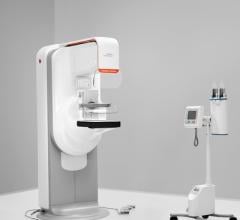This article appeared as an introduction to the Digital Mammography Systems comparison chart.
In the 10 or so years since the U.S. Food and Drug Administration (FDA) gave its first approval to a full-field digital mammography (FFDM) system, there have been numerous developments pushing it to the forefront over conventional film systems. In fact, by the end of 2010, the FDA estimated that about 70 percent of mammography units now in use are digital and 70 percent of certified U.S. mammography facilities have at least one digital unit.
While that already may be considered an impressive inroad, thanks to a recent FDA decision to reclassify digital mammography from class III to class II device status, this expansion is likely to continue. Class II devices are considered medium risk and require only 510(k) certification for approval. This is a quicker process than the premarket approval application required for class III, and a few additional vendors are poised to meet that criteria.
Digital mammography received an early boost from results of the Digital Mammographic Imaging Screening Trial (DMIST) in 2005. The study began in October 2001 and enrolled almost 50,000 women with no signs of breast cancer to compare digital and traditional film mammography. It showed there was similar screening accuracy for the overall population of women studied and that digital was significantly better for three categories of women: those under age 50; those of any age with dense breast tissue, and pre- or perimenopausal women of any age.
What’s more, as reported in the February 2010 issue of the American Journal of Roentgenology,1 a subsequent study of data from DMIST showed the radiation dose associated with digital mammography is significantly lower (averaging 22 percent) than conventional film mammography and could be even more for women with dense breasts. In addition, for many facilities, the fact that digital mammography images can be stored and sent electronically is another advantage.
The past 12 months have seen the introduction of a number of digital mammography system enhancements and related products, although not all are available in the United States yet.
Among them:
• GE Healthcare showed its SenoBright contrast enhanced spectral mammography (CESM) technology at RSNA, as an upgrade to its Senographe DS and Senographe Essential DM equipment. CESM is designed to let a physician image blood flow through angiography of the breast using a contrast agent and a dual energy acquisition technique. This can highlight angiogenesis, the growth of small blood vessels potentially related to the presence of cancer. SenoBright has not received the CE mark and is not available for sale in the United States.
• Also at RSNA, Planmed showed its Nuance Excel FFDM system, which is pending FDA clearance. It features an amorphous selenium direct-conversion detector, 24 by 41 cm size, tungsten tube, Ag/Rh filters and Flex-AEC automated exposure control.
• Hologic introduced Atrix Medical Systems QC-Track quality control software as an enhancement for its Selenia Dimensions 2-D FFDM system in mid-2010. This data capture and graphical reporting software and hardware solution automates the tracking and graphing required by the Mammography Quality Standards Act for many devices associated with breast imaging facilities.
Late last year, Hologic announced it had received an “approvable letter” for the Selenia Dimensions system for breast tomosynthesis (3-D) imaging, which was launched in Europe in 2008. The letter was issued by the FDA’s Center for Devices and Radiological Health.
• Philips made an introduction at RSNA of an advanced stereotactic option for its MammoDiagnost DR. The system, which is not available in North America, includes unique image processing to help clinicians identify tiny microcalcifications and view breast tissue structures.
• In November, the FDA cleared the Volpara breast imaging software for digital mammography systems. It automatically computes volumetric breast tissue density from screening mammograms. It initially was available for Hologic and GE Healthcare systems, with other systems undergoing validation.
References:
1 Am. J. Roentgenol., Feb. 2010; 194: 362-369.


 December 17, 2025
December 17, 2025 









